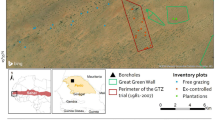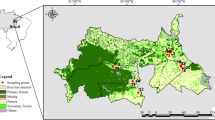Abstract
Slash-and-burn agriculture is an important driver of deforestation and ecosystem degradation, with large effects on biodiversity and carbon sequestration. This study was conducted in a forest in Madagascar, which consists of fragments of slash-and-burn patches, within a matrix of secondary and primary forest. By recording species richness, abundance, and composition of trees, shrubs, and herbs in fallows of various age and slash-and-burn history, and in the secondary and primary forest, we show how slash-and-burn intensity (number of cycles, duration of abandonment), years since last abandonment, and environmental factors (distance to primary forest and topography) affect the natural succession and recovery of the forest ecosystem. We used ordination analyses to examine how the species composition varied between the different successions stages, and to examine tree recruitment. Our results show shrub dominance the first years after abandonment. Thereafter, a subsequent increase in species richness and abundance of tree seedlings and saplings suggests a succession towards the diversity and composition of the secondary and primary forest, although a big gap between the oldest fallows and the secondary forest shows that this will take much more than 30 years. A high number and frequency of slash-and-burn cycles decreased tree seedling and sapling richness and abundance, suggesting that reducing slash-and-burn intensity will increase the speed of tree recruitment and fallow recovery. Trees can be planted into fallows to speed up vegetation and soil recovery, such that fallows can be usable within needed time and thus the extension of cultivated areas reduced. We recommend further testing of six potential species for restoration based on their early colonization of the fallows and their survival through vegetation succession.







Similar content being viewed by others
References
Brady NC (1996) Alternatives to slash-and-burn: a global imperative. Agric Ecosyst Environ 58:3–11
Brearley FQ, Prajadinata S, Kidd PS, Proctor J, Suriantata (2004) Structure and floristics of an old secondary rain forest in Central Kalimantan, Indonesia, and a comparison with adjacent primary forest. For Ecol Manag 195:385–397
Bristow M, Vanclay JK, Brooks L, Hunt M (2007) Growth and species interactions of Eucalyptus pellita in a mixed and monoculture plantation in the humid tropics of north Queensland. For Ecol Manag 233:285–294
Carrière SM, Letourmy P, McKey DB (2002) Effects of remnant trees in fallows on diversity and structure of forest regrowth in a slash-and-burn agricultural system in southern Cameroon. J Trop Ecol 18:375–396
Dalle SP, de Blois S (2006) Shorter fallow cycles affect the availability of noncrop plant resources in a shifting cultivation system. Ecol Soc 11(2):2. http://www.ecologyandsociety.org/vol11/iss2/art2/
Eagler FE (1954) Vegetation science concepts: I. Initial floristic composition, a factor in old field vegetation development. Vegetatio 4:412–417
Faramalala MH, Rajeriarison C (1999) Nomenclature des formations végétales de Madagascar. ANGAP, Antananarivo, p 42
Finegan B (1984) Forest succession. Nature 312:109–114
Gade DW (1996) Deforestation and its effects in highland Madagascar. Mt Res Dev 16:101–116
Gehring C, Denich M, Vlek PLG (2005) Resilience of secondary forest regrowth after slash-and-burn agriculture in central Amazonia. J Trop Ecol 21:519–527
Grace J (2004) Understanding and managing the global carbon cycle. J Ecol 92:189–202
Green GM, Sussman RW (1990) Deforestation history of the eastern rain forests of Madagascar from satellite images. Science 248:212–215
Guariguata MR, Ostertag R (2001) Neotropical secondary forest succession: changes in structural and functional characteristics. For Ecol Manag 148:185–206
Houghton RA, Skole DL, Nobre CA, Hacker JL, Lawrence KT, Chometowski WH (2000) Annal fluxes of carbon from deforestation and regrowth in the Brazilian Amazon. Nature 403:301–304
Hughes RF, Denslow JS (2005) Invasion by a N-2-fixing tree alters function and structure in wet lowland forests of Hawaii. Ecol Appl 15:1615–1628
Lawton RO, Putz FE (1988) Natural disturbance and gap-phase regeneration in a wind exposed tropical cloud forest. Ecology 69:764–777
Lowry PP II, Schatz GE, Phillipson PB (1997) The classification of natural and anthropogenic vegetation in Madagascar. In: Goodman SM, Patterson BD (eds) Natural change and human impact in Madagascar. Smithsonian Institution Press, Washington, DC, pp 93–123
Marcus RR (2001) Seeing the forest for the trees: integrated conservation and development projects and local perceptions of conservation in Madagascar. Hum Ecol 29:381–396
Miller PM, Kauffman JB (1998) Seedling and sprout response to slash-and-burn agriculture in a tropical deciduous forest. Biotropica 30:538–546
Mitja D, de Souza Miranda I, Velasquez E, Lavelle P (2008) Plant species richness and floristic composition change along a rice-pasture sequence in subsistence farms of Brazilian Amazon, influence on the fallows biodiversity (Benfica, State of Pará). Agric Ecosyst Environ 124:72–84
Myers N, Mittermeier CG, DaFonseca GAB, Kent J (2000) Biodiversity hotspots for conservation priorities. Nature 403:853–858
Oxby C, Boerboom JHA (1985) Alternatives and improvements to shifting cultivation on the east coast of Madagascar. In: FAO (ed) Changes in shifting cultivation in Africa, vol 50/1. Food and Agriculture Organization of the United Nations (FAO), Rome, Italy, pp 109–139
Rabemananjara F, Rasamison, Ramandimbison H (2003) Inventaire rapide de la faune herpétologique et entomologique avec diagnostic écologique du corridor forestier Vohimana et alentours. MATE, 21 p
Randrianirina JE (2005) Inventaire biologique de la forêt de Vohimana et de Vohibola. Rapport de mission MATE, 37 p
Roder W, Phengchanh S, Maniphone S (1997) Dynamics of soil and vegetation during crop and fallow period in slash-and-burn fields of northern Laos. Geoderma 76:131–144
Rouw ADE (1993) Regeneration by sprouting in slash and burn rice cultivation. J Trop Ecol 9:387–408
Sala EO, Chapin FS III, Armesto JJ, Berlow E, Bloomfield J, Dirzo R, Huber-Sandwald E, Huenneke LF, Jackson RB, Kinzig A, Leemans R, Lodge DM, Mooney HA, Oesterheld M, LeRoy Poff N, Sykes MT, Walker BH, Walker M, Wall DH (2000) Global biodiversity scenarios for the year 2100. Science 287:1770–1774
Schatz GE (2001) Generic tree flora of Madagascar. Cromwell Press, UK, p 477
Smith J, van de Kop P, Reategui K, Lombardi I, Sabogal C, Diaz A (1999) Dynamics of secondary forests in slash-and-burn farming: interactions among land use types in the Peruvian Amazon. Agric Ecosyst Environ 76:85–98
Styger E, Rakotondramasy HM, Pfeffer MJ, Fernandes ECM, Bates DM (2007) Influence of slash-and-burn farming on fallow succession and land degradation in the rainforest region of Madagascar. Agric Ecosyst Environ 119:257–269
ter Brak CJF, Smilauer P (2002) CANOCO reference manual and CanoDraw for windows user’s guide: software for canonical community ordination (version 4.5). Microcomputer Power, Ithaca, New York, US, p 500
Uhl C (1987) Factors controlling succession following slash-and-burn agriculture in Amazonia. J Ecol 75:377–407
Uhl C, Jordan C, Clark K et al (1982) Ecosystem recovery in Amazon caatinga forest after cutting, cutting and burning, and bulldozer clearing treatments. Oikos 38:313–320
Vieira ICG, Proctor J (2007) Mechanisms of plant regeneration during succession after shifting cultivation in eastern Amazonia. Plant Ecol 192:303–315
Young KR, Ewel JJ, Brown BJ (1987) Seed dynamics during forest succession in Costa Rica. Vegetatio 71:157–173
Acknowledgements
We are indebted to Lesabotsy Razafindravelo, Bernard Maraina, Jean Aimé Rajaonarivelo, Justin Lekamisy, and Rakoto for contributing with historical land use information and species identification, Olivier Behra (MATE) for authorizing the fieldwork, the European Union 6th framework programme for funding this study through the project FOREAIM (project no. INCO-CT-2005-510790), and to two anonymous reviewers for constructive comments on a previous version of this paper.
Author information
Authors and Affiliations
Corresponding author
Rights and permissions
About this article
Cite this article
Klanderud, K., Mbolatiana, H.Z.H., Vololomboahangy, M.N. et al. Recovery of plant species richness and composition after slash-and-burn agriculture in a tropical rainforest in Madagascar. Biodivers Conserv 19, 187–204 (2010). https://doi.org/10.1007/s10531-009-9714-3
Received:
Accepted:
Published:
Issue Date:
DOI: https://doi.org/10.1007/s10531-009-9714-3




